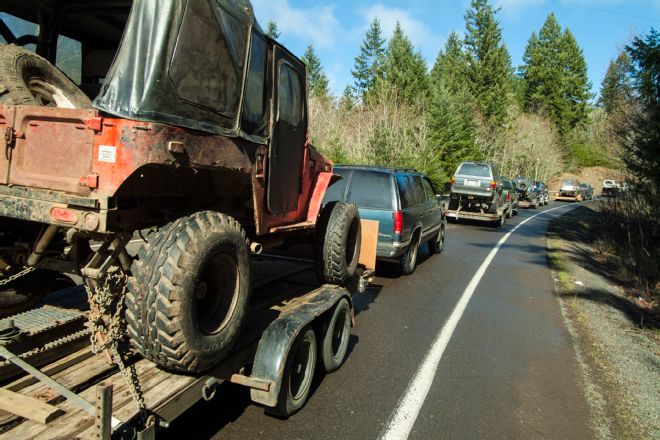
Some of the hot rod guys like to boast that they don’t own a “trailer queen,” but towing is one of the biggest common denominators among the off-road crowd. Getting our toys, be they race trucks, UTV’s, rock crawlers, dirt bikes, mud machines, sand runners or whatever, from home to the playground of choice, is predicated with dropping a trailer tongue on a hitch ball.
The goal is to get our toys, along with family and friends who go with us on such outings, there safely and efficiently – and back the same way.
But to do so requires having the tow vehicle and the trailer it’s towing being properly equipped for the job – and there’re a lot of trailers being towed to OHV areas and off-road events that don’t meet that criteria. Unfortunately, many of those drivers are unaware of the danger they pose to themselves and those sharing the road with them.
That danger stems solely from drivers not following the tow vehicle manufacturer’s well-defined requirements for the weight of the trailers being towed. Where all this safety concern comes into play is when the trailered weight approaches the tow vehicle’s max tow capacity.
That’s why every vehicle manufactures places towing restrictions and requirements on the cars, SUVs and pickups we drive, and makes those restrictions and requirements clear in the owner’s manuals and factory trailering guides.
Trailer Limitations
For example, according to the 2016 Ram 1500-3500 owner’s manual, the biggest trailer you can safely tow on the factory hitch, using the conventional ball-and-shank, is 5,000 pounds.
To be “properly equipped” by the vehicle manufacturer’s definition requires trailers above that weight to use a “weight-distributing” hitch assembly. (Weight-distributing hitches use spring bars to shift some of the weight on the hitch ball forward onto the tow vehicle’s front axle and rearward to the trailer’s axles.) Those same 5,000-pound trailering limitations/requirements apply to Ford F-150s, Toyota Tacomas/Tundras, GM Colorado/Canyons, Nissan Titans/Frontiers and pre-2016 GM 1500s.
Ford Super Duty diesels are required to have a weight-distributing hitch in play when towing trailers in excess of 8,500 pounds according to Ford’s trailering guide and owner’s manual. Late-model GM HDs, on the other hand, can tow up to 13,000 pounds with the use of a W-D hitch “optional,” according to the company’s towing guidelines.
The Liability Side
Why is it important to know where this trailer weight cutoff point is between using a normal hitch and a W-D? Liability.
In a nutshell, it’s the driver’s responsibility to operate any vehicle in a safe and responsible manner. If that’s not done and there’s some tragic accident where lives are lost, then liability raises its ugly head – and lawsuit lawyers come running. Where that applies to towing is if the vehicle isn’t “properly equipped” per the vehicle manufacturer’s guidelines, then the driver wasn’t operating the vehicle in a safe and responsible manner. And that’s easy to prove: weigh the trailer and see if the driver was using the proper hitch setup for the trailered weight. If not, it can be construed as negligence on the driver’s part.
According to Dean Holleman, Vice President and Managing Attorney of Boyce Holleman & Associates (www.boyceholleman.com) in Gulfport, Mississippi, “If the accident is caused by the vehicle being used to tow something it was not designed to tow, this in itself could be an act negligence by the tow [vehicle] driver and under the theory of negligence he could be liable (and most probably would be held liable).”
At that point the insurance company of the driver towing the trailer will most likely throw their hands up and walk away while the lawyers of those injured or killed will be angling for a big settlement.
Off-road enthusiasts with their own businesses should also take towing with properly setup vehicles and trailers seriously because the “Law of Negligence” (http://injury.findlaw.com/personal-injury/personal-injury-law/negligence/) can have an even greater, far-reaching affect on them should something unforeseen happen.
But such concerns can be easily put aside if the tow vehicle/trailer combo is properly setup.
Setup For Best Handling Setting up a tow vehicle and trailer properly not only avoids those potential legal pitfalls, it just makes good sense from a driving aspect.
A properly equipped tow vehicle towing a properly loaded trailer is an easy drive. There’s no drama; the nose of the tow vehicle isn’t sitting high, the trailer doesn’t sway, and the combination takes bumps, dips, off-camber corners just fine. It’ll also handle emergency situations, like panic braking or swerving to miss something in the road, without the driver losing control. On the other hand, a tow vehicle that isn’t properly setup is a dicey drive at best.
The first goal is to make sure the weight of the loaded trailer is within the manufacture’s towing guidelines for whatever type of hitch that’s on the tow vehicle. Too much weight on the trailer tongue pushes the rear of the vehicle down, the front up, upsetting steering and braking.
That’s why the second goal is to make sure the trailer tongue weight is at least 10 percent of the weight of the loaded trailer and less than 15 percent – and that tongue weight doesn’t exceed the maximum allowed by the vehicle manufacturer.
An easy way to get tongue weight exactly where you want it is by using a scale, or faster yet, using a Weigh-Safe Hitch (weigh-safe.com) that has a scale built right into it.
To get the right trailer balance, a good starting point is to place 60 percent of the load over the front half of the trailer and balanced evenly from side to side. Trailers loaded with too much weight fore or aft of the axles can create trailer instability, such as trailer sway, at highway speeds and during heavy braking.
Lastly, if the trailered weight requires the use of an aftermarket weight-distributing hitch, use one.
Towing should be taken very seriously. The toys and trailer in-tow are costly investments and taking care they get to/from the destination unharmed is important. But they are not nearly as important as making sure you, your friends and family, and those sharing the road with you, are as safe as possible – and that the person doing the towing is doing so in a safe and responsible manner.
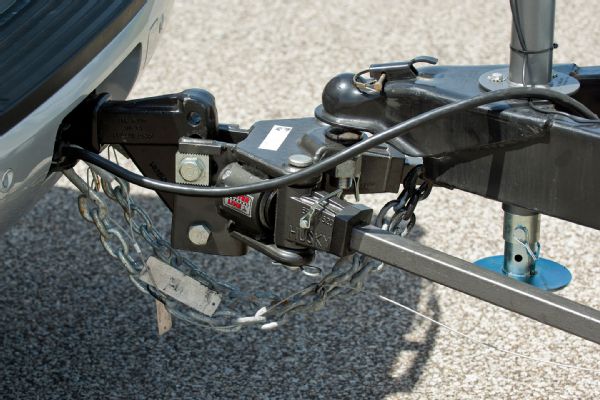
Making Trailer Connections
Hooking up trailer to tow ball is so easy most off-roaders give it little thought. But trailering newbies may not have it down pat, so here’re a few quick tips:
• Make sure the hitch coupler fits the hitch ball.
• Lock the couple latch and place a pin or bolt through the hole in the latch to keep it from accidentally popping open in transit.
• Hook the break-away brake cable to the hitch.
• Cross the safety chains and attach to the hitch.
• Safety chains should be equipped with locking quick links, not open “S” hooks.
• Don’t twist the chains to make them shorter if they are touching the ground at that weakens the chains.
• Plug in the trailer lights and check all functions.
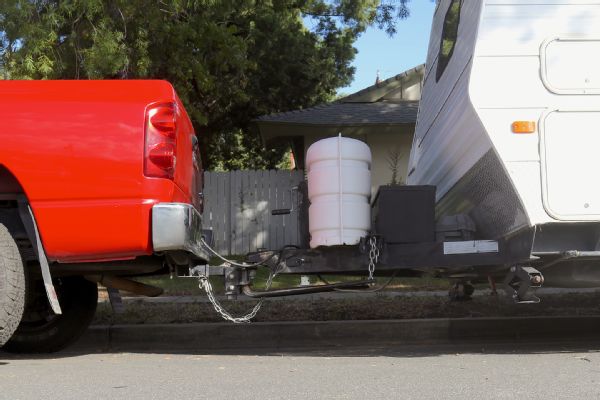
Weight Distributing Hitch Setup Tips
We’re big fans of weight-distributing hitches (W-D). We remember our dad telling us about when he first saw a demonstration of the then-new product. The company (we believe it was Easy-Lift, but don’t hold us to a 40 year old memory) put one on a front wheel drive Cadillac Eldorado, hooked up a trailer and then proceeded to remove the rear wheels and drive around the place with not a care in the world. Needless to say, our travel trailer had one in place.
Setting up a W-D system shouldn’t be intimidating, and once it’s setup for your tow vehicle/trailer, it only takes a few seconds longer to hook up than it does dropping a trailer on a weight-carrying hitch.
A W-D’s spring bars work like handles on a wheelbarrow to move that weight front/rear. To make it easy to snap the spring bar chains into the hook on the trailer frame brackets, crank the trailer tongue jack to lift the weight off the hitch ball while keeping the latter locked in place.
Setting up a W-D hitch is two-fold: 1) making sure the trailer tongue weight is distributed so the front height of the truck (between tire and fender lip) is the same (or at most an inch higher) as it was before hitching the trailer; and at the same time 2) adjusting the hitch head so the trailer frame is slightly tongue-low to the ground plane.
Lower the jack until the W-D hitch is carrying the load, and measure the height at the front to see if the spring bar-chain needs to be taken up or down a link. Shortening the spring bar chains increases the amount of weight being move to the front of the truck and rear of the trailer, and vise versa.
Once the weight is distributed correctly, the second goal is making sure the hitch head angle and ball height is adjusted so the trailer tongue is about an inch lower than level with the pavement. This usually requires loosening the bolts that hold the hitch head so it can be rotated to raise/lower the trailer tongue to get the angle correct and retightening. Slotted spacer plates keep the head in position.
Remember: The spring bars adjust weight-distribution front/rear. The hitch head adjusts ball height and levelness of the trailer.
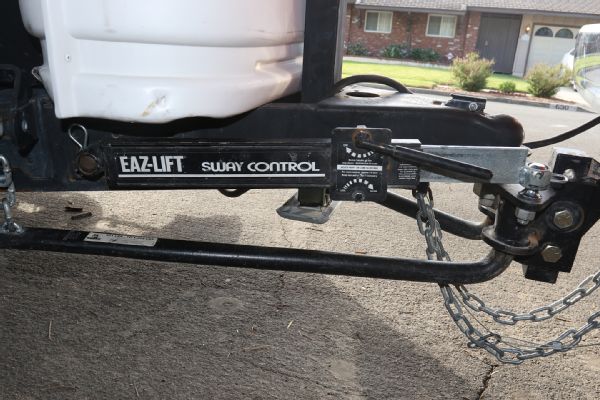
Friction Sway Controllers Puts The Squeeze On
We’ve talked about keeping the truck/trailer combo level and how it improves handling, but one of the best ways to keep that trailer tracking straight is with a friction based sway controller. Simple in its design, a friction based sway control unit attaches to the hitch and to one side of the trailers tongue frame and work by way of a clamping sliding mechanism. They operate on the principle of "stiffening" the coupling between the tow vehicle and trailer and help to keep the trailer behind the tow vehicle in adverse conditions such as high winds, curvy roads and abrupt panic braking situations. Two (one on each side) are recommended on trailers measuring over 26-feet in length. Note that they cannot be used with “surge” type braking systems.
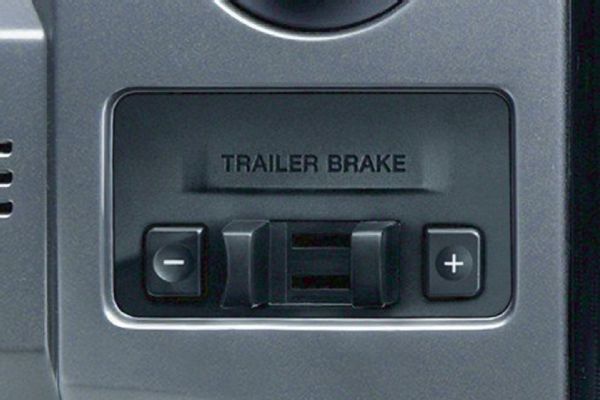
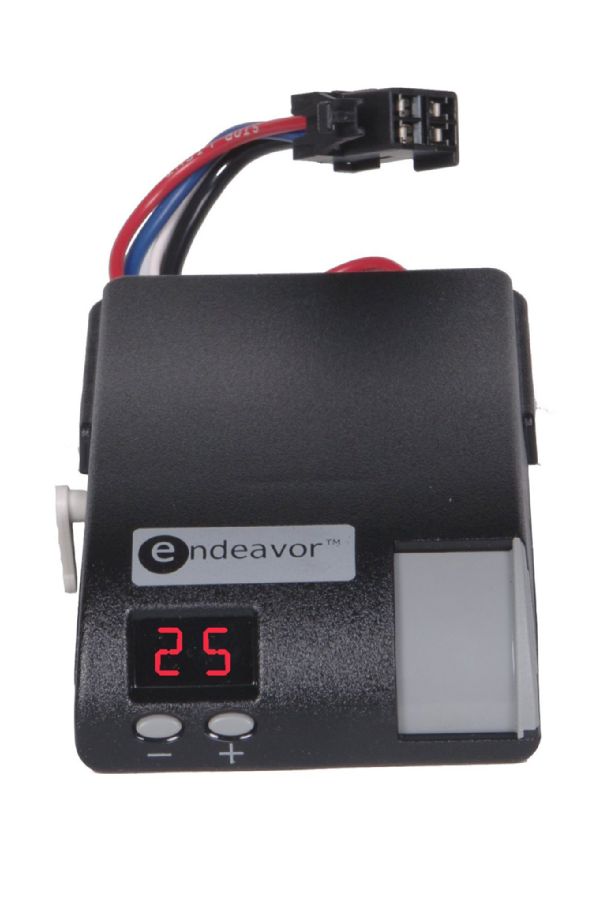
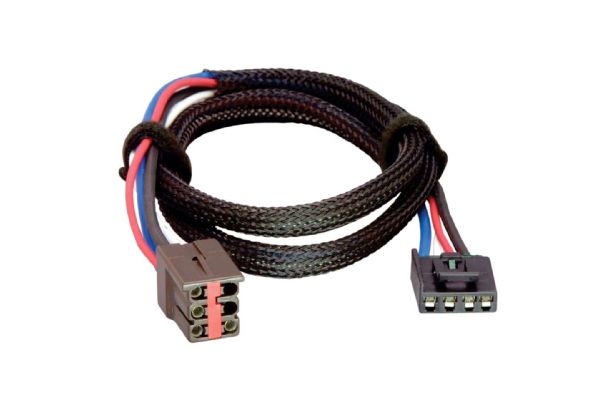
Setting The Brake Controller
If you are towing a trailer that weighs more than 5,000 pounds, it’s going to have electric brakes and the tow vehicle will need a brake controller.
Most of today’s heavy-duty pickups have brake controllers built-in, while ½-tons and SUVs offer them as an option. For those who need to install one though, installation is a snap literally as if the tow vehicle has a “Tow Option,” then there’s a connector plug beneath the dash that the controller’s pigtail simply plugs into. When installing ours, it took us longer to pull a dash panel and drill a wiring access hole to mount the unit than it did to actually make the wiring connections. We put ours into a dash cubby to make things cleaner, thus the drilling, but the units can simply be hung below the dash from its bracket. In that case, install time is about 10 minutes.
When it’s time to adjust a brake controller, in general the goal is to have the “gain” adjusted just below the point where the trailer’s brake’s lockup when the tow vehicle’s brakes are hit hard at 20-25mph on dry pavement. (Read the vehicle and/or brake controller’s manual for specifics, as there are many different makes/models.)
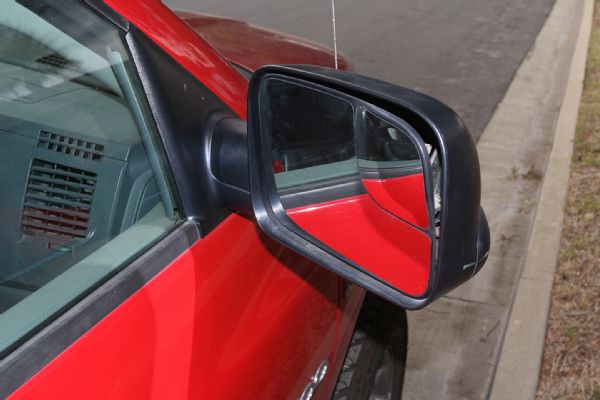
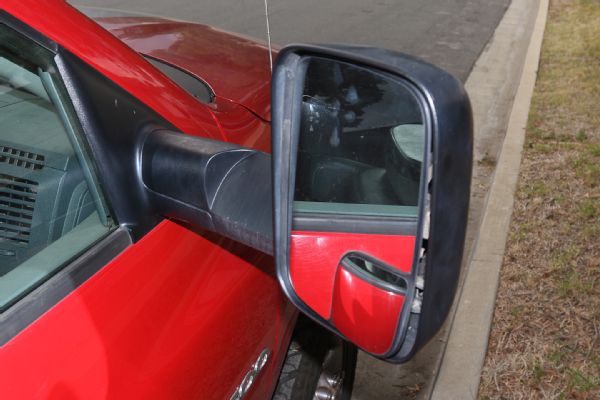
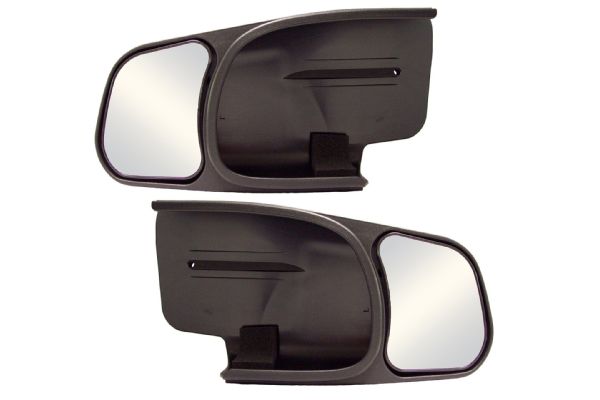
Mirrors
Keeping an eye on what’s going on behind you is doubly important when towing. All states require mirror extensions be in place while towing, and it’s just a smart idea anyway.
Many trucks now have towing mirrors built in to the stock units. Ford’s extend out, and Dodge has a flip-out design, but there are companies that make extensions that slide onto the existing mirrors and lock into place. They even look good, as they are designed to match the styling cues of the stock units.
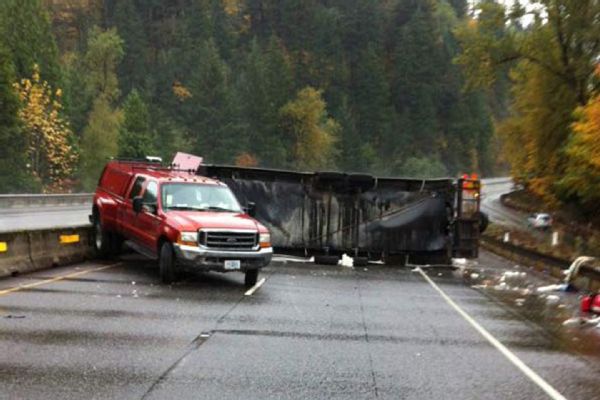
Controlling Trailer Sway Without A Sway Controller
Trailer sway is both dangerous and scary. It means you are seconds away from something very bad happening if the problem isn’t immediately rectified. A sway control bar is the best way to prevent this, but if you don’t have one, read on.
Sway is the result of imbalance between the tow vehicle and the trailer, which usually the result of improper weight distribution, excessive speed or overloading. When crosswinds, cornering on a section of off-camber road, or other conditions come into play, the trailer and tow vehicle start oscillating out of synch.
Trying to steer out of sway usually makes matters worse. So will hard braking. The key to bringing a swaying trailer back under control is to take the following steps quickly and smoothly:
• Hold the steering wheel as steady as possible
• Do not touch the brake pedal
• Lift off the throttle
• Hand-activate the electric trailer brakes (if equipped) until the vehicle is brought back under control
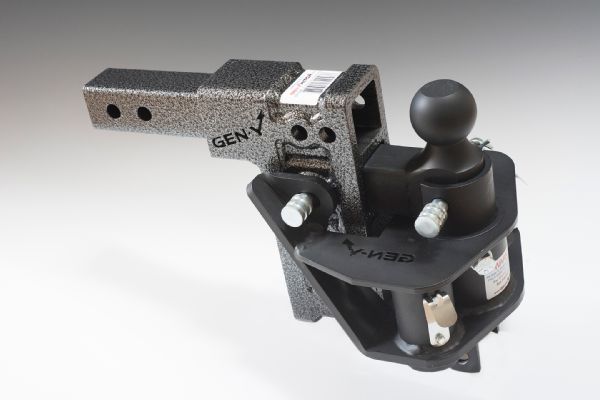
Gen Y Hitch Review
One of the most innovative weight-distributing hitches on the market today is the 13,000-pound-capacity Gen-Y Hitch, which is a special Class V hitch that can be changed from an adjustable ball hitch to a weight-distributing hitch in seconds. Think of it as the Transformer of trailer hitches.
This Gen-Y W-D hitch, which is made in America by Easy Hitch, combines a cast-steel, boxed drop-type adjustable drawbar along with the company’s Versa-Ball shank as the base for conventional weight-carrying needs in both 2- and 2 ½-inch sizes.
What makes this hitch so innovative is it quickly converts to a weight-distributing hitch just by sliding the spring bar receiver head over the Versa-Ball and locking it in place with two 5/8-inch pins – one through the hitch ball and one through the GH-304 shank that slides into the truck’s receiver hitch.
Gen-Y’s weight-distributing hitch is versatile, stout, well designed, and doesn’t require any tools to change the position of the hitch head. It also has a wider range of adjustment than normal weight-distributing hitches because it uses just the one pin to move the ball/head up/down the boxed shank, which has 7.5 inches of drop.
That adjustment latitude and ease of use makes the Gen-Y W-D hitch well suited for 4x4 pickups with moderate lifts.
GEN-Y HITCH
Genyhitch.com
574-218-6363
2016 “WEIGHT-CARRYING” TOW RATINGS
Not sure how heavy a trailer your 2016 pickup can tow before the factory requires the use of a weight-distributing hitch? Here’re the numbers as indicated in the manufacturer’s trailering guides and/or owner’s manuals:
Chevrolet
Colorado: 5,000 pounds/500 pounds TW
1500: 7,000 pounds/700 pounds TW
2500/3500HD: 13,000 pounds/1,300 pounds TW
Ford
F-150: 5,000 pounds/500 pounds TW
F-250/350 SRW (Gas): 6,000 pounds/600 pounds TW
F-250/350 6.7L SRW: 8,500 pounds/850 pounds TW
F-350 Dually/F-450: 8,500 pounds /850 pounds TW
GMC
Canyon: 5,000 pounds/500 pounds TW
1500: 7,000 pounds/700 pounds TW
2500/3500HD: 13,000 pounds/1,300 pounds TW
Nissan
Frontier: 5,000 pounds/500 pounds TW
Titan: 5,000 pounds/500 pounds TW
Ram Truck
1500/2500/3500: 5,000 pounds/500 pounds TW
Toyota
Tacoma: 5,000 pounds/500 pounds TW
Tundra: 5,000 pounds/500 pounds TW

Off-road enthusiasts tow a variety of trailers to their favorite stomping grounds. These sand lovers towed everything from flat-decks to toy haulers to travel trailers to 5th wheels. Every one of them has their own needs and requirements.
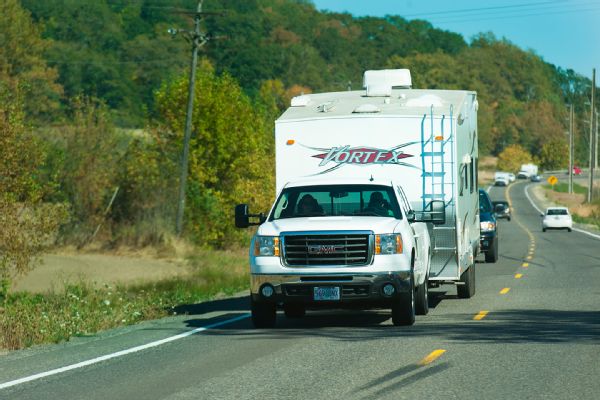
This toy-hauling pickup’s nose-high attitude and nose-low trailer position shows the combo’s not properly setup for the trailer it’s towing.
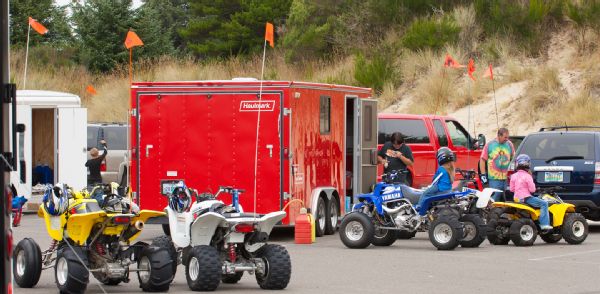
Balancing the load properly in a toy hauler or enclosed trailer is important when there are multiple machines.
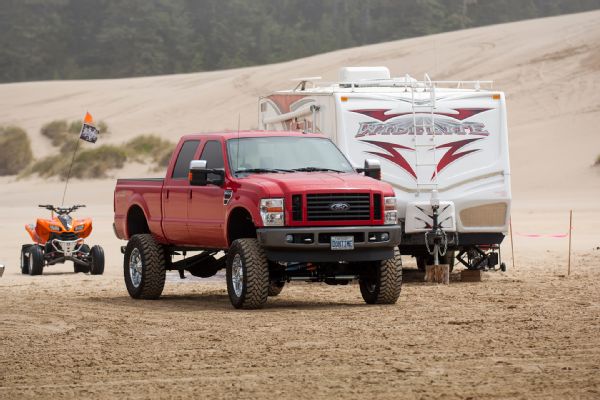
Lifted pickups are more prone to trailer towing issues because of the higher center of gravity and changes in spring rates. Proper trailer setup is critical for safety sake.
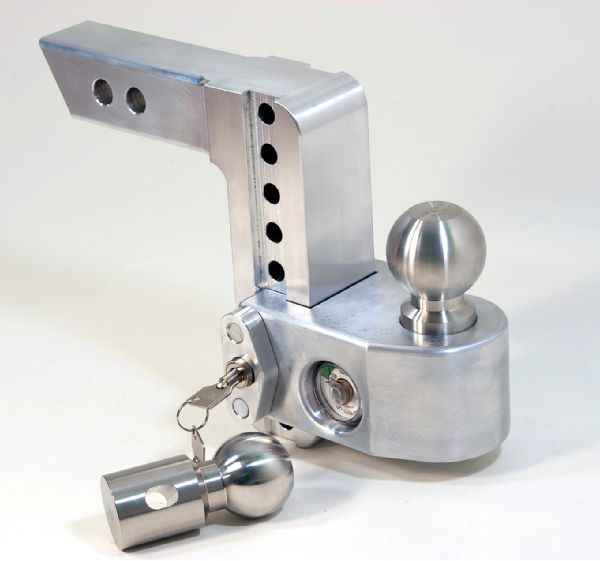
Adjusting trailer tongue weight is easy with these new weight-carrying hitches from Weigh-Safe. TW is indicated on dial built in to the shank.
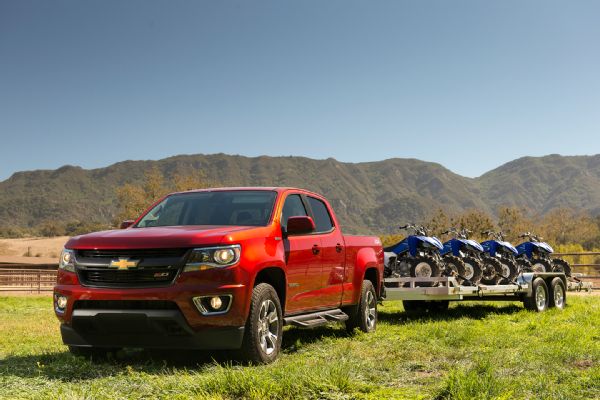
Chevrolet’s 2016 Colorado diesel can tow up to 7,600 pounds but requires a weight-distributing hitch on trailered loads weighing more than 5,000 pounds.
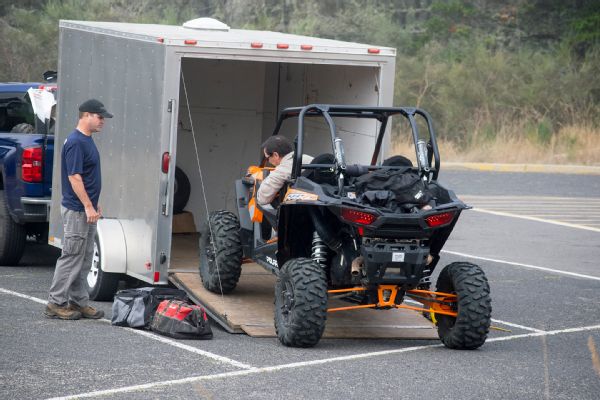
Balancing load in trailers is important. The best method is watching the tongue weight, which should be 10-15% of the loaded trailer’s weight.
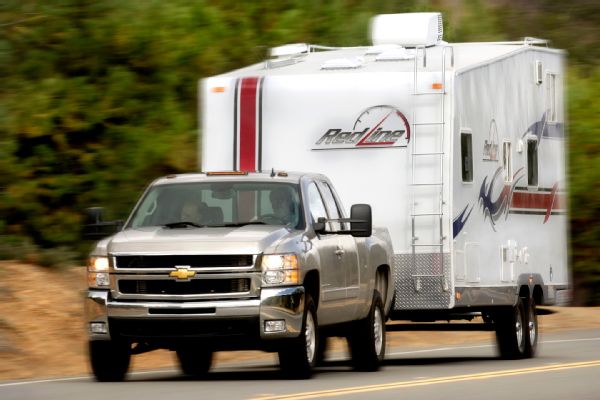
Every vehicle manufacturer has specific towing requirements that are noted in the owner’s manuals and on the factory trailering guides found on the Internet.
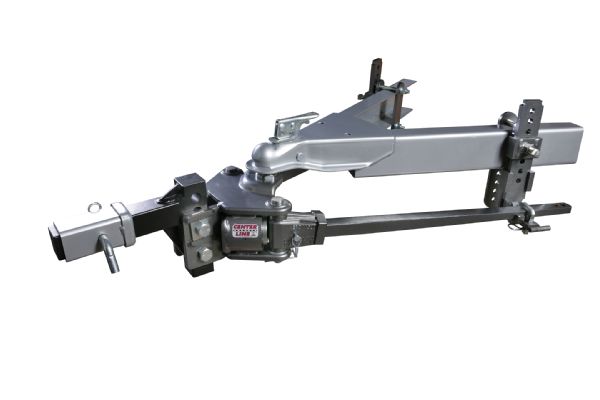
One of the newer weight-distributing hitches on the market is the Husky Centerline, which has built-in trailer sway control.